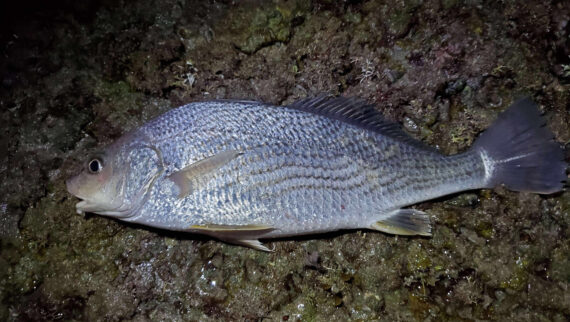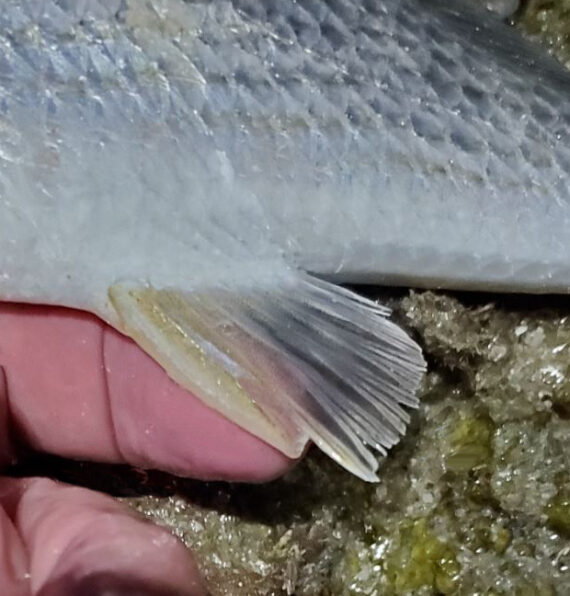Cortez Croaker, Umbrina wintersteeni

 Cortez Croaker, Umbrina wintersteeni. Fish caught from shore at Puerto Peñasco, Sonora, October 2016. Length: 25 cm (10 inches). Catch and photographs courtesy of Chris Moore, Peoria, Arizona. Second photo is an excellent view of the anal fin and its second thick spine, a key to a correct identification of this species.
Cortez Croaker, Umbrina wintersteeni. Fish caught from shore at Puerto Peñasco, Sonora, October 2016. Length: 25 cm (10 inches). Catch and photographs courtesy of Chris Moore, Peoria, Arizona. Second photo is an excellent view of the anal fin and its second thick spine, a key to a correct identification of this species.
The Cortez Croaker, Umbrina wintersteeni, is a member of the Croaker or Sciaenidae Family, and is known in Mexico as berrugata de Cortés. This fish was first reported by my good friend H.J. Walker, Jr. (with Radford) in 1992. Globally, there are eighteen species in the genus Umbrina, of which seven are found in Mexican waters, one in the Atlantic and six in the Pacific Ocean.
The Cortez Croaker has a moderately elongated, oblong, and slightly compressed body with a horizontal lower profile. They have a uniform silvery golden-brown coloration with a series of undulating oblique dark lines along their scale rows. Their fins are dark with the exception of their pectoral fins which are pale. They have high backs that are strongly curved at the front. Their head is broad, conical, and low and features a snout that is longer than the eye diameter and opens in the front under a projecting snout. Their gill covers are finely serrated. Their chin has 1 short barbel with a pore at its tip and 2 pairs of pores at its base. Their gut cavity is pale. Their anal fin 2 spines and 6 rays with the second spine being stout and half the length of the first ray and the base is short; their caudal fin has a straight or slightly rounded margin; their first dorsal fin has 10 spines; their second dorsal fin has 1 spine and a long base and 23 to 28 rays; and, their pectoral fins are short. They are covered with rough scales.
The Cortez Croaker is a demersal species found over sandy bottoms, in the surf zone, and in inshore bays at depths up to 15 m (50 feet). They reach a maximum of 35 cm (14 inches) in length. As of January 1, 2024, the International Game Fish Association world record stood at 0.57 kg (1 lb 4 oz), with the fish caught from coastal waters off Puerto Peñasco, Sonora, March 2023. They are carnivores feeding on benthic crustaceans, worms, and gastropods. The Cortez Croaker is poorly studied with very limited information available about their lifestyle and behavioral patterns including specific details on age, growth, longevity, movement patterns, diet, habitat use, and reproduction.
The Cortez Croaker is a resident of Mexican waters of the Pacific Ocean but has a limited distribution being found from Magdalena Bay, Baja California Sur and throughout the Sea of Cortez.
The Cortez Croaker can be confused with the Longspine Croaker, Umbrina analis (dark fins), the Surf Croaker, Umbrina xanti (thin second anal spine three-fourths the length of first anal fin ray), and the Yellowfin Croaker, Umbrina roncador (second anal spine three-fourths the length of first anal fin ray).
From a conservation perspective the Cortez Croaker is current considered to be Data Deficient. Although rare and small in stature, the Cortez Croaker is viewed by locals as excellent table fare when available.